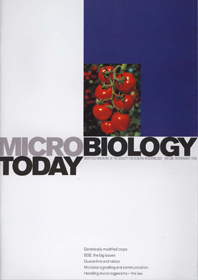GM plants
01 February 1999 publication
The lead articles of the February 1999 issue of Microbiology Today are on genetically modified crops; BSE: the big issues; quarantine and rabies; microbial signalling and communication; and handling micro-organisms – the law.
Ethics and the microbiologist (p. 02)
Ray Spier speculates on the ethical issues that arise for microbiologists.
Genetically manipulated food for thought (p. 03)
A look at GM plants – are they good or bad?
One swallow does not a summer make (p. 04)
John Heritage takes a microbiological look at genetically modified crops.
Predicting the effects of genetically modified organisms – more questions than answers (p. 06)
Sue Mayer discusses the possibilities and risks of genetic modification.
BSE: the big issues (p. 08)
The government inquiry to establish and review the history of the emergence and identification of BSE and new variant CJD in the UK ran through most of 1998, a report released in June. SEAC has an important and difficult role in advising the government on all matters related to TSEs. Here, John Pattison gives a personal view of the major issues that have confronted SEAC over the past few years.
Quarantine and rabies (p. 10)
In 1997 the Ministry of Agriculture, Fisheries and Food (MAFF) set up an Advisory Group or Quarantine [AGQ(Rabies)] to assess the risk of the introduction of rabies into the UK under the current policy of quarantine and alternatives. Ulrich Desselberger discusses.
Meeting preview: Microbial signalling and communication (p. 11)
A preview of the topics to be discussed at the SGM Main Symposium at Edinburgh.
Who did invent the Petri dish? The mystery deepens (p. 13)
Milton Wainwright speculates on the real origin of the Petri dish.
Handling and distribution of micro-organisms and the law (p. 14)
David Smith, Christine Rohde and Barry Holmes discuss the responsibilities placed on the shoulders of microbiologists and the potential consequences of failure to follow the national and international legislation. Ignorance is no excuse in the eyes of the law.
International Development Fund report (p. 17)
Gerry Saddler reports on the Caribbean regional training course on the taxonomy and identification of plant-pathogenic fungi and bacteria of agricultural importance.
A European Centre for Infectious Disease (ECID): a need for the future (p. 18)
What can be done to combat the threats from infectious disease in the 21st century? Jean-Claude Piffaretti talks about a new collaborative venture that is actively being considered by a group of microbiologists from around the world.
Going Public (p. 33)
Liz Sockett reports back on the children's microbiology lectures at the Royal Institution.
Gradline (p. 34)
This issue contains details of the SGM Young Science Writer Award competition, and Catherine Owens explains what Bdellovibrio is and does.
Comment – The way forward for British science (p. 48)
Peter Cotgreave discusses what is needed for British science to progress.

